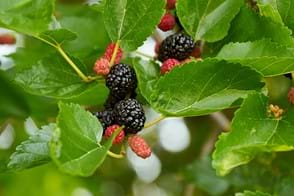Mulberries can suffer from two main diseases: Fungal Leaf Spot (Phloeospora maculans) and Bacterial Blight (Pseudomonas syringae). Both diseases can cause defoliation on your Mulberry trees and have the potential to occur simultaneously on the same tree.
Fungal Leaf Spot only affects leaves. They show as small dark brown spots that have a green or yellow halo, gradually becoming larger. The leaf slowly dies, turning white with dark brown margins and the fungus then spreads throughout the tree via wind and rain splash. Implementing good hygiene practices, such as promptly raking up fallen leaves and ensuring proper air circulation around the tree, can help alleviate the problem.
Bacterial blight on Mulberries is a more serious problem because it affects the new shoots and leaves. Newly emerging leaves in spring will have large angular brown or black spots that are surrounded by a yellow halo, and leaves become distorted and curled. Cankers will develop on stems that die back. Bacteria oozes from these cankers and spreads through the tree.
During autumn, it is important to prune off all the dead wood and completely remove any infected material from the site. Maintaining good hygiene practices is vital to effectively control the spread of diseases.









